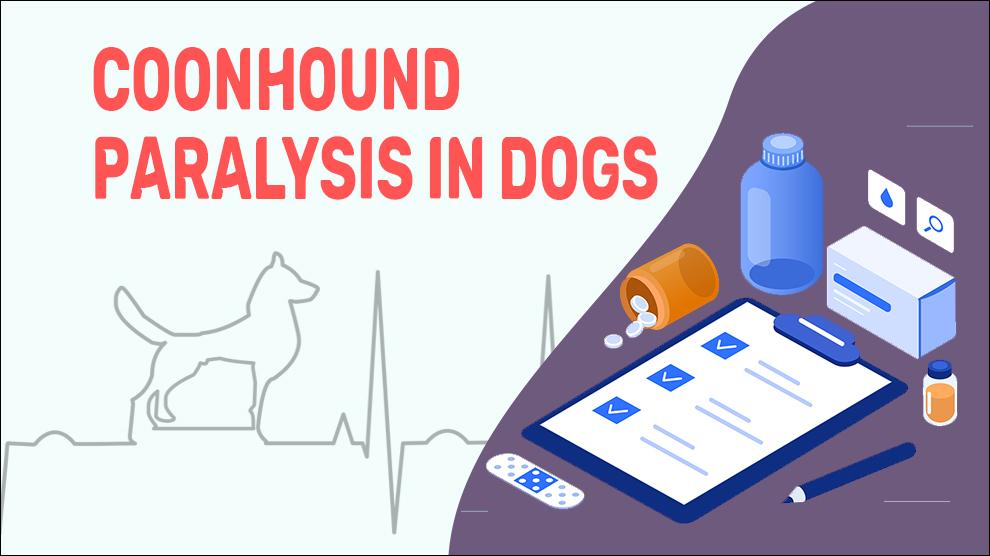Coonhound Paralysis (CHP) is a rare, autoimmune, or acquired neurological inflammation affecting transmission at the peripheral nerves and multiple nerve roots. This can be caused by an immune reaction in dogs that come in contact with raccoon saliva after being bitten or scratched by a raccoon. Rarely, it can also occur in dogs who have not contacted a raccoon. In this case, it is idiopathic and it is called acute canine idiopathic polyradiculoneuritis (ACIP).
CHP pathogenesis is a similar condition is Landry- Guillain-Barre Syndrome (GBS) in humans. In GBS, our own immune system attacks the nervous system damaging the protective coating on nerves and causing weakness and tingling in the legs that progress to the arms and upper body. In severe cases, this results in total paralysis. Axon damage is a more consistent finding in CHP than GBS.
The raccoon hunting breeds or breeds that encounter raccoons are potentially susceptible. While CHP dogs may not be able to express the pain they are feeling because of the paralysis but the sensation of pain is intact.
Considering the fact that the neural pathways are drawn in, research is in progress to find out the link of CHP to an autoimmune disorder. As of now, it is believed that WBCs are attacking the nerves which cause muscle failure.
It is better to understand that prognosis is different for individual dogs. Some dogs may recover within a few weeks, while many others may take months. One way to prevent this disease is to keep dogs away from raccoons and supervise them while out in wooded or rural areas.
Symptoms Of Coonhound Paralysis
The hind limbs - Ascending flaccid paralysis begins.
- Facial and laryngeal weakness.
- Decrease in muscle mass.
- Decreased reflexes and facial muscle strength.
- Labored breathing
- Dry eye
- Inability to walk properly/Falling.
- Inability to stand/move for long periods of time.
- The desire to rest rather than exercise and move around.
Treatment Options For Coonhound Paralysis
There is no specific cure for coonhound paralysis but it can be treated to relieve symptoms.
Intravenous fluid and nutritional therapy may be given to help your dog if it becomes severely dehydrated.
Immunosuppressive or anti-inflammatory medications.
Immunosuppressive Therapy:
Prednisone at 2 - 4 mg/kg PO (4 to 6 months, with no more than a 50% decrease in the dose every month).
After which a minimal maintenance dose to subside clinical signs is enough.
Azathioprine: 2 mg/kg PO q24 then 48h.
Methotrexate: 2.5 mg/mL.
Cyclosporine (immunomodulator): 5mg/kg PO q12h.
Physical Therapy: Massage can help relieve the dog’s sore muscles.
Home Remedies For Coonhound Paralysis
Obviously, optimizing your pet’s nerves should be the top priority for preventing nerve conditions from happening in the first place.
Diet: Nutritionally balanced, wholesome diet formulated for the dog’s size and lifestyle.
Weight: Maintenance of ideal weight for the dog.
Exercise: Right amount of exercise, low-intensity exercise such as hydrotherapy.
Supplements: Muscle, Nerve, and spine supplements.
Prevention Of Coonhound Paralysis
Any dog breed that tends to have contact with raccoons is potentially susceptible, so prevent the dogs from the raccoons.
Affected Breeds Of Coonhound Paralysis
Coonhounds and dogs that come in contact with Racoons.
Additional Facts For Coonhound Paralysis
- Causes:
- Raccoon hunting dogs
- Autoimmune disorder
- Types:
True Coonhound Paralysis: After contacting raccoon saliva through a bite or scratch, Signs will manifest within 7-14 days.
Idiopathic Polyradiculoneuritis: Autoimmune disorder. The symptoms typically start in 4-5 days and for maximum symptoms to appear it can take up to 10 days.
Affected dogs soon have a stiff-legged gait that progresses rapidly to paralysis of all four legs. The nerves that are connected with the spinal cord and the muscles are affected.
- Mortality:
Most of the cases have a normal life span even in severe cases; most dogs can continue to live comfortably with treatment. The life expectancy of CHP dogs is normal except in rare cases.
- Diagnosis:
- Nerve and muscle biopsy
- Biochemical and genetic testing
- CT scan and MRI
- Lumbar puncture (spinal tap).
- Nerve conduction studies and electromyography (EMG).
- Differential Diagnosis:
- Toxoplasmosis
- Tick paralysis
- Botulism
- Tetanus
- Prognosis:
Coonhound paralysis can be very mild to severe. The outcome is typically good for a complete recovery unless severe difficulty eating or the presence of cancer or severe pneumonia.
CHP treatment in dogs usually lasts for months. Your vet will periodically re-examine the pet on a regular basis to check about improvements. Even in severe cases, early diagnosis, and with appropriate treatment, your pet may make a full recovery.
When To See A Vet
Contact your vet right away, if you notice any of the following:
- The hind limbs - Ascending flaccid paralysis begins.
- Facial and laryngeal weakness.
- Decrease in muscle mass.
Food Suggestions For Coonhound Paralysis
Foods to avoid:
- Avoid fatty foods or high in fiber.
- Cutback on greasy, oily, spicy foods.
- Avoid crunchy or chewy snack foods.
- Avoid dairy products like milk, yogurt, etc.
- Bread products and roasted nuts.
- Avoid tougher meats.
What to feed:
- Smaller, more frequent meals of high-quality, high-calorie food.
- Choose softer foods such as mashed, soft, or pureed foods.
- Moisten/soften foods with chicken broth, gravy, or butter.
- Finely chop up veggies, chicken, or meat.
- Watch the salt intake of dogs such as from canned soups or frozen meals.
- Add calcium-rich foods and supplements such as broccoli, salmon, Sardines, and Dark leafy greens.
Conclusion
Although CHP is treatable, most pets require months of medication and special feeding.
Pet owners should remember that it is a progressive condition and we can try to slow the progression.
With the right supportive care and medications, pets can live a longer, quality life.

















